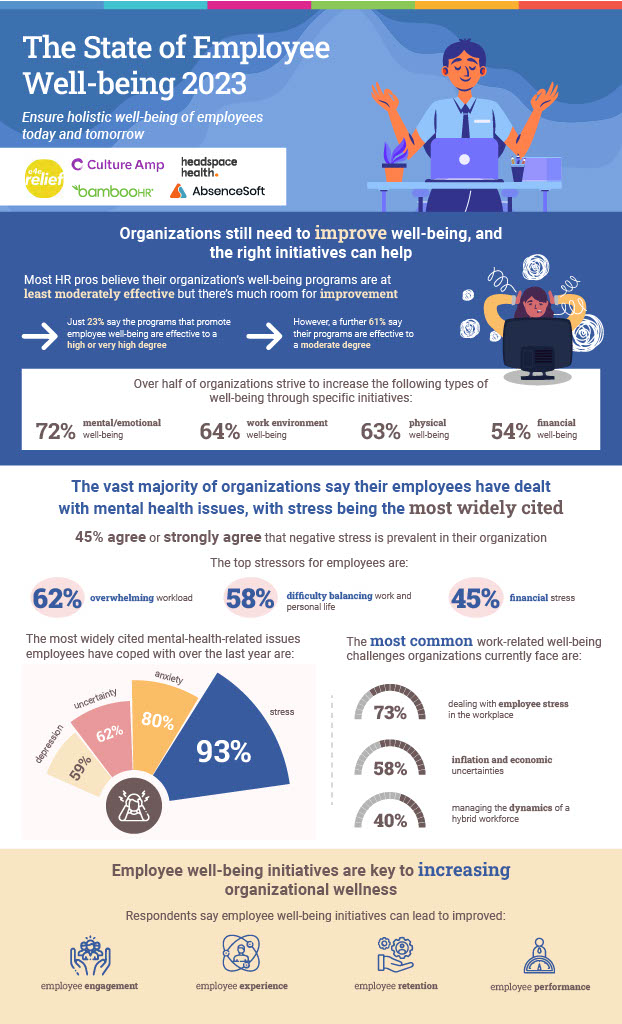In recent years, employee wellbeing has become a top priority for most organizations following the pandemic. Recently, however, some wellbeing leaders are concerned that these initiatives could be first on the chopping block due to headlines around layoffs, even impacting influential figures like Google's head of mental health and wellness.
But is this just an isolated incident—or the start of a worrying trend? More broadly, is employee wellbeing still a priority in 2023?
According to “The Future of Employee Wellbeing 2023” report from HR.com, the answer is an emphatic yes. The survey—which compiles responses from over 300 employer and employee groups across a wide range of industries and business sizes—found that nearly 40% of organizations have wellbeing in their top 10 HR priorities, with around 36% reporting it to be in the top three.
However, a high priority doesn’t always translate to progress. To understand the current state (and future) of employee wellness, let’s take a closer look at the survey results, including insights from WellRight’s own unique data.
Here’s What Employers Have To Say About Workplace Wellness
 (Click on image to view larger.)
(Click on image to view larger.)
While the pandemic’s impacts were pervasive in last year’s "State of Employee Wellbeing 2022" report, this year, employees and employers appear to finally be settling into the new normal—but that doesn’t mean they’re becoming complacent.
On the contrary, many employers are leveraging employee wellbeing initiatives to elevate workplace culture and promote overall wellbeing.
Similar to 2022, mental health is still the primary focus among employer groups, with nearly 72% of organizations prioritizing specific initiatives to enhance this aspect of the workplace—followed by work environment (63.6%), physical health (63.3%), and finances (53.7%). Yet this is still only one small piece of the puzzle.
In addition to mental health, the HR.com survey uncovered several key trends in employee wellbeing:
1. Wellness Initiatives: Efficacy, Barriers, and Challenges
Efficacy
WellRight’s survey data shows that just under 55% of organizations report their wellness initiatives to be “moderately effective,” which is echoed by HR.com’s reported 60.8%. Meanwhile, only 22% report theirs to be highly or very highly effective.
Of course, these numbers are great, as it demonstrates that wellness programs are delivering some level of results for over 80% of organizations—but what might be holding back the remaining 20%?
Barriers
For organizations that ranked their initiatives’ efficacy as low to very low in the HR.com survey, about half reported this was due to a low number of programs.
On the other hand, based on written feedback from select survey respondents, low engagement was the No. 1 reason why their programs weren’t as effective as they could be. This underscores the importance of tracking wellness programming and user data to continuously optimize its effectiveness and drive employee engagement.
Challenges
No matter how organizations rank their program’s efficacy, they all must deal with work-related challenges at some point.
Their primary obstacle? For almost 74% of organizations, the main challenge remains managing employee stress in the workplace. This is somewhat unsurprising, considering the focus on mental and emotional health, but it’s never been more critical to invest in programming that mitigates stress and provides healthy management techniques.
2. What’s Stressing Employees Out?
While managing stress is an inevitable part of life, no one should have to deal with elevated levels for prolonged periods of time—especially in the workplace. Not only can it lead to health issues, but the tension can also quickly degrade company culture.
Yet over 67% of WellRight’s respondents agree or strongly agree that negative stress is pervasive in their organization, and less than 30% report it is effectively addressed and dealt with.
This year, the three most common stressors for employees are: an overwhelming workload (70.3%), difficulty balancing work and life (57.4%), and financial stress (45.5%). And although finances are the lowest of the three, the number still shows an over 11% increase from 2022.
So what is causing this financial stress for employees? According to the HR.com survey, organizational leaders consider childcare, unexpected emergency expenses, and difficulty saving to be the biggest reasons behind employee financial stress.
But that doesn’t mean it’s a personal failing. Instead, it highlights the importance of financial well-being initiatives in promoting a healthy (and fiscally responsible) lifestyle.
For instance, WellRight’s survey shows over 55% of organizations offer financial literacy workshops or resources—far outweighing any other types of well-being initiatives.
3. The Big Picture of Employee Mental Health
Coinciding with the theme of employee stress, mental health emerged as another prevalent concern for employees and employers.
Over the past year, organizations reported stress and anxiety as the two most pervasive mental health issues in the workplace, at 92.7% and 80.2%, respectively. Just below that, around 60% of organizations reported uncertainty and depression in their workforce as significant deterrents to workplace well-being.
WellRight’s data echoes these results, with over 76% of organizations struggling to address employee stress in their workplaces. However, the good news is that they’re aware of these difficulties and making efforts to change them.
Around 67% of organizations have set goals in the last two years to provide more educational sources to help employees cope with stress. Similarly, many employers are launching specific initiatives to support their employees’ mental health, such as:
- Employee Assistance Program (EAP) services (79.2%)
- Flexible work arrangements (57%)
- Mental health benefits (55.6%)
- Stress management programs and resources (43%)
These programs and services aim to provide employees with solutions that are designed to reduce stress and accommodate various mental health challenges in the workplace.
4. Remote and Hybrid Work Arrangements
Speaking of occupational well-being, another key theme from this year’s survey results was the new normal of hybrid and remote working arrangements.
Of course, many companies are effectively making the transition back into the office, but others have realized the potential of non-traditional models—and they’re sticking with them. In fact, over one-third of organizations agree that remote or hybrid work has improved the mental health and wellness of their employees.
However, hybrid workforces also come with unique challenges. For nearly 42% of employers, managing the dynamics of in-person and remote team members can be difficult. Still, unwilling to part with the benefits of working from home, almost 62% of organizations have allowed more employees to work remotely at times in the last two years.
5. How Effective Are Corporate Wellness Strategies?
The final major theme from HR.com’s 2023 report covers the current effectiveness of corporate wellness programs and initiatives themselves. In the last two years, organizations have used a wide range of strategies to promote employee well-being, from providing informational resources to expanding hybrid work arrangements. But what are the actual outcomes?
Overall, it appears workplace wellness strategies have been most successful in driving employee engagement, with 43.6% of organizations agreeing they saw more active participation and involvement. Similarly, just over 40% of respondents reported an improved employee experience.
And the best part? The benefits have extended to employers as well, with over 37% of companies seeing an increase in employee retention and around 30% reporting improved performance.
On the flip side, wellness strategies can also be an effective recruitment tool. Not only are over half of all employees most interested in health benefits, but nearly 27% of organizations also reported an increase in candidate attraction due to their wellness initiatives.
The Current State of Employee Well-Being
After reviewing current trends in employee wellbeing, it’s clear that wellness is still a top priority for many companies—but it’s also becoming an integral part of corporate strategy. In the last two years, over half of all organizations reported moderate results in their wellbeing programs, with almost 20% reporting a very high degree of success. So what does the future hold?
According to the results, remote and hybrid work arrangements are the No. 1 wellbeing initiative organizations plan on utilizing in the next two years, followed closely by informational resources and financial wellness programs.
To read “The Current State and Future of Employee Wellbeing 2023” research report or to check out the infographic from HR.com Research Institute, download it here.



